Jp’s Gold Thread
-
Similar Content
-
- 16 replies
- 903 views
-
- 2 replies
- 318 views
-
- 13 replies
- 1,868 views
-
- 5 replies
- 8,583 views
-
Rye Patch Nevada Rare Specimen Gold, Crystals, Field Training & Photos 1 2
By Gerry in Idaho,
- gold found
- nevada
- (and 1 more)
- 17 replies
- 1,380 views
-
- 8 replies
- 650 views
-
-










Recommended Posts
Create an account or sign in to comment
You need to be a member in order to leave a comment
Create an account
Sign up for a new account in our community. It's easy!
Register a new accountSign in
Already have an account? Sign in here.
Sign In Now